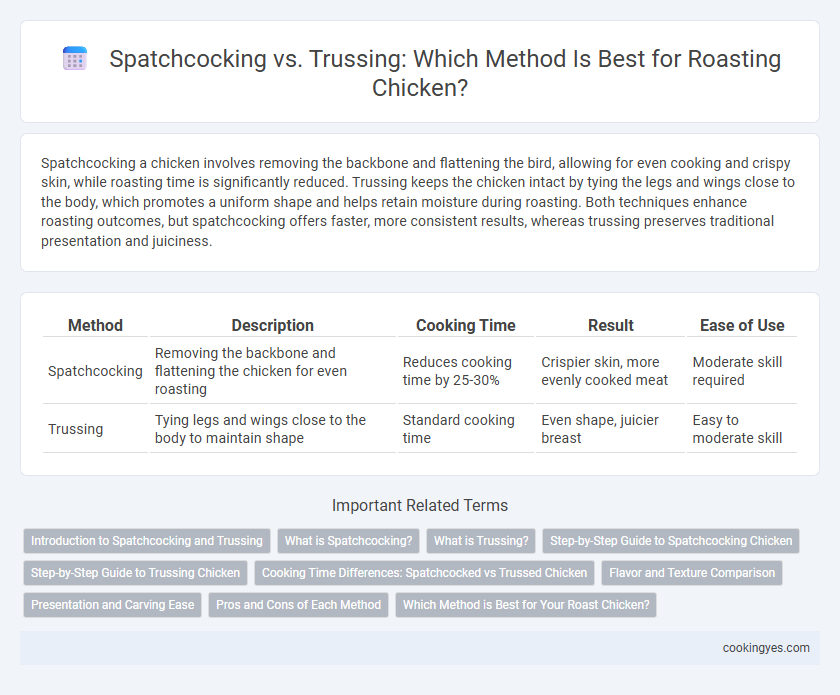Spatchcocking a chicken involves removing the backbone and flattening the bird, allowing for even cooking and crispy skin, while roasting time is significantly reduced. Trussing keeps the chicken intact by tying the legs and wings close to the body, which promotes a uniform shape and helps retain moisture during roasting. Both techniques enhance roasting outcomes, but spatchcocking offers faster, more consistent results, whereas trussing preserves traditional presentation and juiciness.
Table of Comparison
| Method | Description | Cooking Time | Result | Ease of Use |
|---|---|---|---|---|
| Spatchcocking | Removing the backbone and flattening the chicken for even roasting | Reduces cooking time by 25-30% | Crispier skin, more evenly cooked meat | Moderate skill required |
| Trussing | Tying legs and wings close to the body to maintain shape | Standard cooking time | Even shape, juicier breast | Easy to moderate skill |
Introduction to Spatchcocking and Trussing
Spatchcocking involves removing the chicken's backbone and flattening it for even cooking and crispier skin, reducing roasting time significantly. Trussing ties the legs and wings close to the body, promoting uniform shape and preventing uneven drying during roasting. Both techniques enhance cooking efficiency and presentation but cater to different roasting preferences and outcomes.
What is Spatchcocking?
Spatchcocking involves removing the chicken's backbone and flattening the bird for even roasting, which reduces cooking time and results in crispier skin. This technique allows heat to penetrate more uniformly, enhancing flavor and juiciness throughout the meat. Compared to trussing, spatchcocking ensures faster, more consistent roasting without restricting the bird's natural shape.
What is Trussing?
Trussing involves tying a whole chicken with kitchen twine to secure the wings and legs close to the body, promoting even cooking and maintaining the bird's shape during roasting. This technique helps prevent the extremities from drying out while ensuring the breast meat cooks uniformly. Unlike spatchcocking, which flattens the chicken by removing the backbone, trussing preserves the bird's original form for a classic presentation.
Step-by-Step Guide to Spatchcocking Chicken
Spatchcocking a chicken involves removing the backbone with kitchen shears and flattening the bird by pressing down on the breastbone, allowing for even roasting and crispier skin. Begin by placing the chicken breast-side down, cutting along both sides of the backbone, and discarding it or saving for stock. Flip the chicken over and press firmly on the breast to flatten, then season and roast at 425degF for 35-45 minutes until the internal temperature reaches 165degF.
Step-by-Step Guide to Trussing Chicken
Trussing chicken involves tying the legs and wings close to the body using kitchen twine to promote even cooking and retain moisture during roasting. Begin by placing the chicken breast-side up, tuck the wing tips under the body, loop the twine under the tail, and pull the legs together tightly before knotting securely. This method enhances presentation and ensures the chicken cooks uniformly without drying out.
Cooking Time Differences: Spatchcocked vs Trussed Chicken
Spatchcocking a chicken significantly reduces cooking time by flattening the bird for even heat distribution, allowing it to roast faster compared to trussed chicken. A spatchcocked chicken typically cooks in about 35 to 45 minutes at 425degF, while a trussed chicken requires 60 to 75 minutes at the same temperature due to its compact shape. This difference improves skin crispiness and juiciness by exposing more surface area during roasting.
Flavor and Texture Comparison
Spatchcocking chicken involves removing the backbone and flattening the bird, which allows for more even heat distribution and crispy skin due to increased surface area exposure, enhancing flavor intensity and producing juicier meat. Trussing chicken keeps it compact, promoting uniform cooking and moistness by retaining juices within the cavity, resulting in tender texture but less crispy skin. Flavor development is more robust in spatchcocked chicken as the direct heat caramelizes the skin and juices more efficiently compared to the slower, gentler roasting in trussing.
Presentation and Carving Ease
Spatchcocking a chicken involves removing the backbone and flattening the bird, resulting in more even cooking and a visually appealing, flat presentation that highlights crispy skin. This method simplifies carving by allowing easy access to the breast and thigh meat without resisting a bulky shape. In contrast, trussing keeps the chicken whole and compact, producing a classic, rounded appearance but can make carving more challenging due to the bird's tighter form.
Pros and Cons of Each Method
Spatchcocking chicken involves removing the backbone and flattening the bird, which speeds up cooking time and ensures even roasting with crispy skin, but it requires additional preparation skills and tools. Trussing chicken secures the legs and wings close to the body, promoting uniform shape and compactness for moist, evenly cooked meat, though it can limit airflow and crisping on some parts of the skin. Choosing between spatchcocking and trussing depends on the desired texture, cooking time, and presentation preferences.
Which Method is Best for Your Roast Chicken?
Spatchcocking a chicken involves removing the backbone and flattening it, resulting in faster, more even cooking with crispier skin and juicier meat. Trussing, by tying the legs and wings close to the body, maintains a traditional shape that ensures uniform cooking and better presentation, especially for stuffed birds. For maximum roasting efficiency and enhanced flavor, spatchcocking is best suited, while trussing is ideal when appearance and consistent shape are priorities.
Spatchcocking vs Trussing for Roasting Chicken Infographic

 cookingyes.com
cookingyes.com